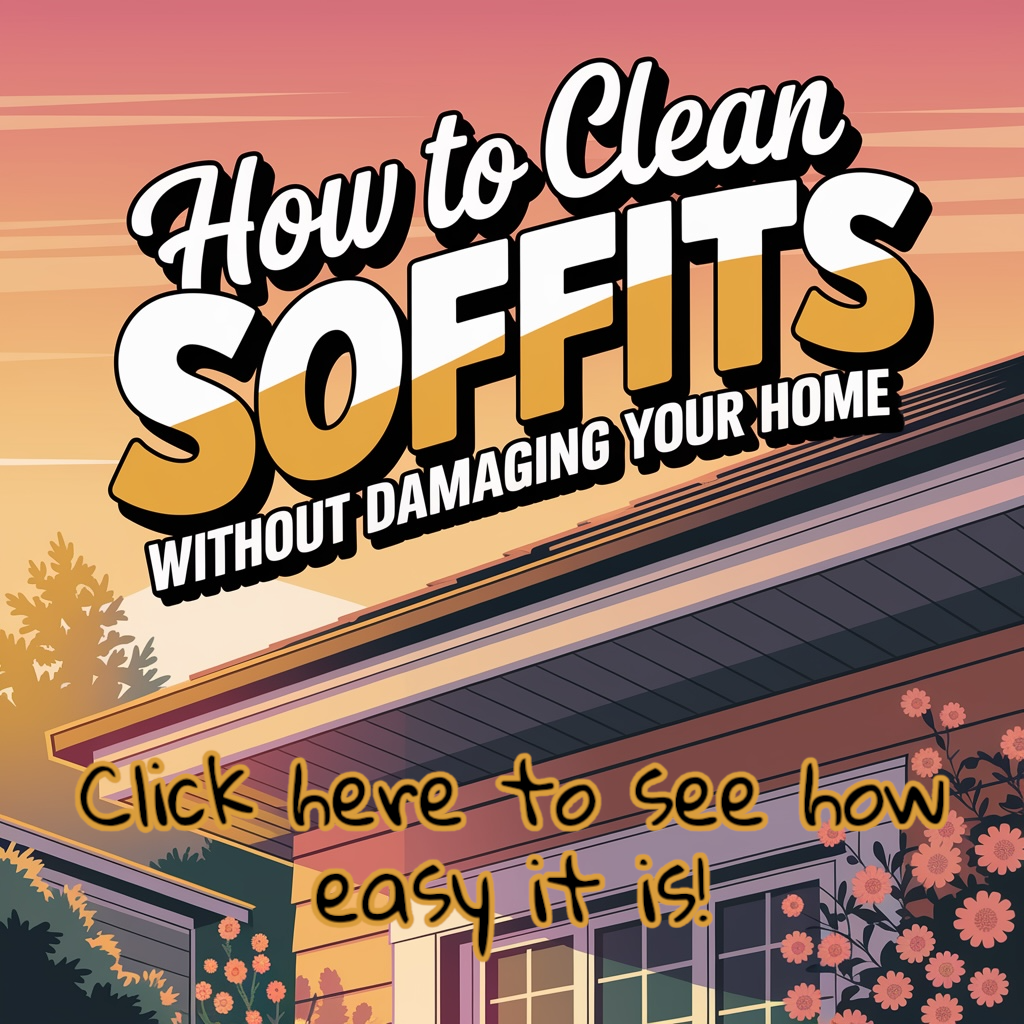
What Causes Algae Growth on Vinyl Siding?
When I first noticed the greenish stains creeping up my siding, I figured it was just dirt. Turns out, it was algae. If you’re dealing with the same issue, here’s what I’ve learned: algae loves moisture, shade, and surfaces that never get fully dry.
The north side of my house was especially bad. It gets barely any sunlight, stays damp after rain, and sits near some shrubs. All of that creates the perfect little ecosystem for algae to thrive.
Algae isn’t just ugly—it can also break down your siding over time and leave behind tough stains. And trust me, once it takes hold, it only spreads.
If you already see the green stuff creeping in, here’s the good news: you don’t have to power wash or replace anything. Check out my article on how to clean algae off vinyl siding the easy way to get ahead of it before jumping into prevention mode.

How I Keep My Siding Algae-Free (And What Actually Works)
After dealing with algae more than once, I figured out a routine that actually keeps it off — and no, it doesn’t involve scrubbing every month.
Here’s what works for me:
- Seasonal spray with 30 SECONDS Outdoor Cleaner
I use this stuff twice a year and it seriously makes a difference. It hooks right up to my garden hose, and the hose-end sprayer makes it easy to coat the siding in just a few minutes.
👉 30 SECONDS Outdoor Cleaner - Rinse with plain water every few months
Sometimes a quick rinse is all it takes to knock dust and grime loose before it turns into something worse. - Trim back bushes and tree branches
Plants hold in moisture and block sunlight. Once I trimmed everything back, the siding dried out quicker after rain and algae didn’t come back as fast. - Clear out leaves and mulch piled against the foundation
These things act like sponges. Wet mulch = moist siding. I learned that the hard way.
If you want to keep the outside of your house looking fresh, it’s a lot like maintaining indoor air — regular care really does go a long way. I apply the same idea when using a DIY air filter fan to freshen up the air inside, and the same rule applies to siding: prevent buildup before it becomes a mess.

Best Times of Year to Apply Algae Preventative Sprays
Through trial and error, I found the two best times to apply algae-prevention spray to my siding are:
- Early spring – Right before the weather gets warm and humid, which is when algae likes to wake up and spread.
- Late fall – After leaves fall and before winter moisture sets in, I give the siding a good rinse and spray to lock in cleanliness before the cold season.
Doing it these two times each year has dramatically reduced the amount of buildup I see on my siding. If I wait too long, I notice green patches creeping back on the shady side of the house — fast.
If your home sits near trees or bushes, or if it faces north like mine does, you may even want to do a mid-summer rinseas a bonus.

Should I Pressure Wash to Keep Algae Away?
Honestly? Not unless you really need to.
Pressure washing can blast away algae, but it can also damage vinyl siding, force water behind panels, and stir up more problems. I’ve done it once and regretted it.
Instead, I rely on cleaners like the 30 SECONDS Outdoor Cleaner I mentioned earlier. It’s gentle, effective, and won’t wreck your siding. For routine maintenance, a regular garden hose and a long-handled brush or mop is all you need. If you’re wondering about more safe maintenance gear, check out my favorite outdoor sprayer gun that can double up for fence and siding applications.
The key is frequency over force — it’s better to lightly clean a few times a year than to go nuclear with a pressure washer once every few years.

How to Improve Airflow and Sunlight Around Your Siding
One of the most underrated fixes I ever made was clearing up airflow around my siding. It made a huge difference.
Here’s what I did that actually helped stop algae from coming back:
- Cut back dense shrubs and bushes – I had some landscaping way too close to the walls. Once trimmed, the siding could finally dry out faster after it rained.
- Removed that old trellis – It was blocking sunlight on one side of my house. After I took it down, that area stayed cleaner and drier.
- Added a little stone border – Around the base of the house to stop mulch from piling up and holding moisture. This tip alone helped reduce that green tint near the foundation.
The more airflow and sunlight your siding gets, the less moisture sticks around — and moisture is algae’s best friend. So even if you love a lush garden look, leave some breathing room near your house.
If you’re into building beautiful outdoor paths or garden edges like I am, check out how I built a DIY garden arbor for under $50 to frame a little mulched area. It adds charm without choking off airflow to my siding.

Watch Out for Drainage Problems Near the House
If your siding is constantly damp, check the ground around your home. I had no idea my downspout was dumping water right onto a patch of soil that sloped back toward the house — algae heaven.
Here’s what I did to fix it:
- Extended the downspout with a cheap plastic diverter to direct water away.
- Re-graded a low spot with some dirt and gravel to push water outward.
- Added splash blocks under other downspouts just to be safe.
Now, even after a storm, my siding dries up within a day or so — and algae hasn’t returned in that area since.
If you’re into outdoor problem-solving like this, you might want to check out my post on how to fix a leaning fence without replacing it — another smart fix that keeps your yard looking sharp and solid.

Don’t Let Dirt and Pollen Build Up on Siding
This was a small habit I changed that made a big difference.
I used to wait until my siding was visibly green before doing anything. But over time, I learned that dirt and pollen are algae’s favorite snacks — they feed the growth and hold moisture too.
So now I do this:
- Once every couple of months, I rinse the siding with a garden hose, especially during heavy pollen seasons.
- I use a soft siding brush with an extender pole and give the north side of my house a quick once-over — no soap, just water and elbow grease.
- During fall, I knock off any clinging leaf bits or cobwebs that hold in moisture.
This tiny routine keeps the siding cleaner for longer and helps me avoid having to use harsh chemicals as often. It pairs perfectly with my go-to 30 SECONDS Outdoor Cleaner when I do deeper cleans in spring and fall.

When to Call a Pro (and When You Don’t Need To)
I’m all about doing things myself, but there are times when calling a pro just makes sense.
Here’s when I would hire someone:
- If the algae has spread to hard-to-reach upper levels and I don’t feel safe on a ladder.
- If I’m dealing with stubborn black mold spots that didn’t budge after two cleanings.
- If I’m prepping the house for sale and want it to look spotless fast.
But if it’s regular green or light brown algae on accessible siding, I save a ton by doing it myself with a hose, brush, and cleaner. If you’re looking for other DIY money-saving wins, check out my post on fixing low water pressure without replacing pipes — another job I used to think I had to call someone for.

Best Times of Year to Clean and Treat Your Siding
Timing matters more than I used to think.
Here’s what I’ve found works best when trying to stay ahead of algae growth on vinyl siding:
- Early spring – This is when pollen starts coating everything, so it’s a great time to give siding a pre-season rinse and a light scrub.
- Late summer or early fall – Right before the cooler, wetter months. A deeper clean with something like 30 SECONDS Outdoor Cleaner clears off all that summer buildup.
- After long rainy streaks – If you’ve had constant rain for a week or more, check your shady areas and spray off what you can.
Waiting too long means buildup gets baked in or hidden behind climbing plants. So I try to get ahead of it with some regular checks — just like I do when inspecting for algae or mold on indoor air filters.

Keep Algae Off Before It Even Starts!
The trick I’ve learned with algae is that it’s a lot easier to prevent than remove. Since I started treating my siding proactively, I’ve gone from cleaning twice a year to maybe once — and it’s way easier.
Here’s what I always remind myself:
- Shade + moisture = algae. Fix those two and you’re 80% there.
- Keep it clean, dry, and aired out.
- And when in doubt, hit it with the 30 SECONDS Outdoor Cleaner before things get slimy.
If you’re just now learning about how to deal with green gunk on your house, check out my guide on how to clean algae off vinyl siding the easy way — it’s got step-by-step help and everything I’ve learned from trial and error.

As an Amazon Associate we earn from qualifying purchases through some links in our articles.



